This Creamy Salmon Chowder combines the delicate flakiness of salmon with the creamy richness of a luscious broth, the heartiness of tender potatoes, and the sweetness of corn. This recipe is made using everyday staple ingredients and is sure to be a family favorite.
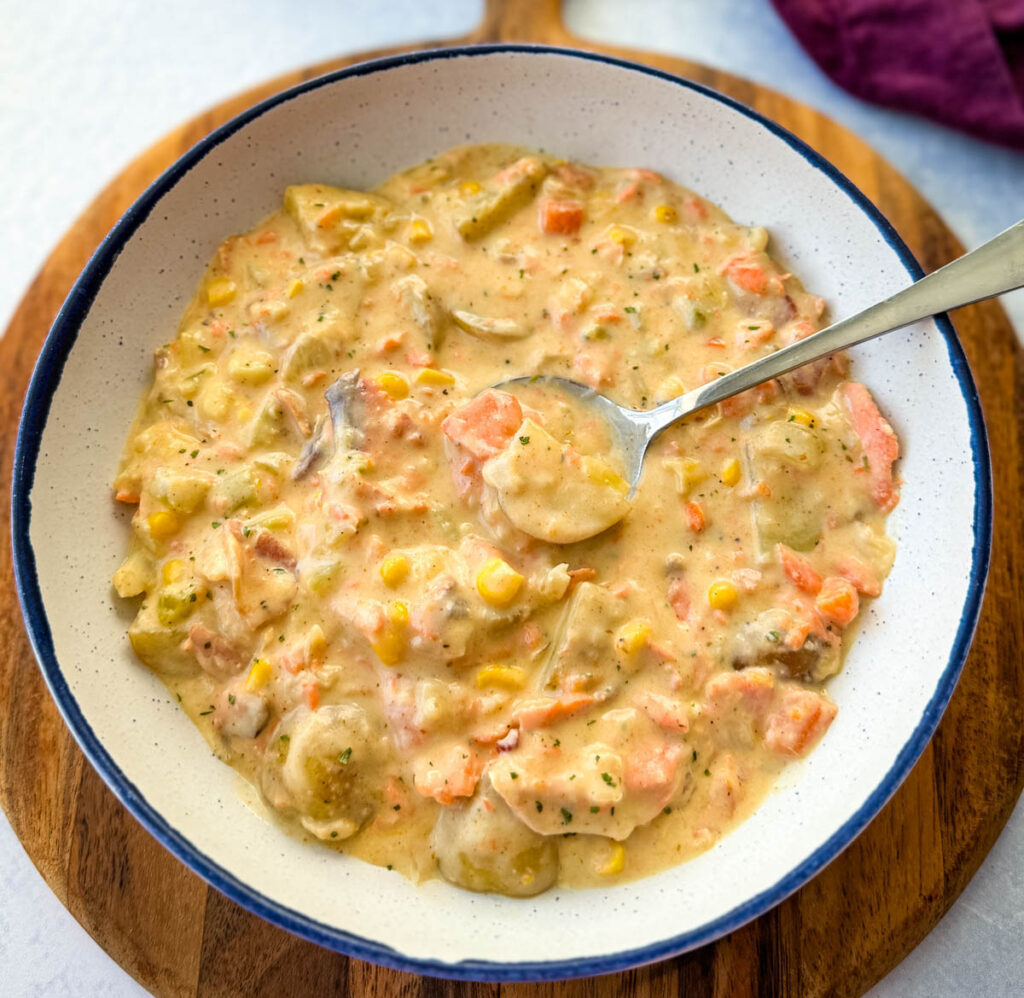
Want to save this recipe for later?
Table of Contents
Key Ingredients
- Bacon (Optional)
- Butter
- Flour
- Carrots
- Onion
- Celery
- Corn
- Broth
- Salmon
- Heavy Whipping Cream
- Spices
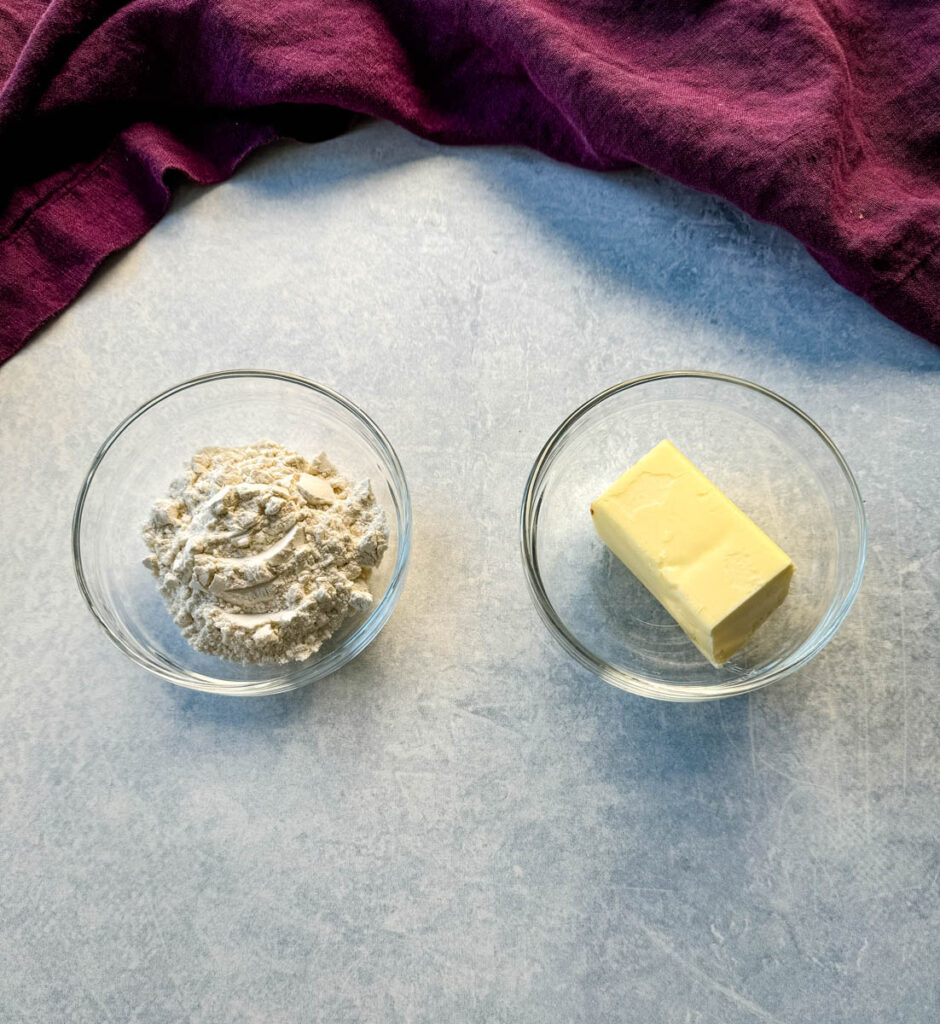
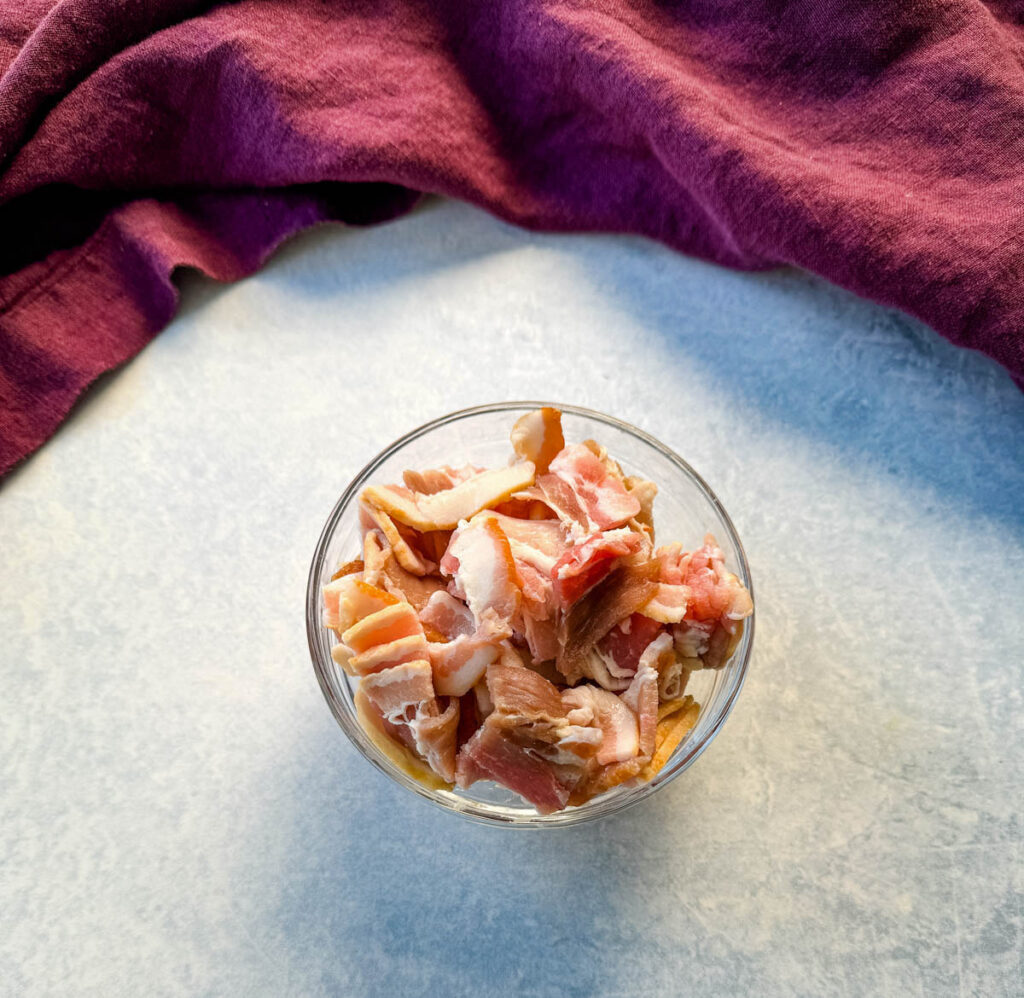
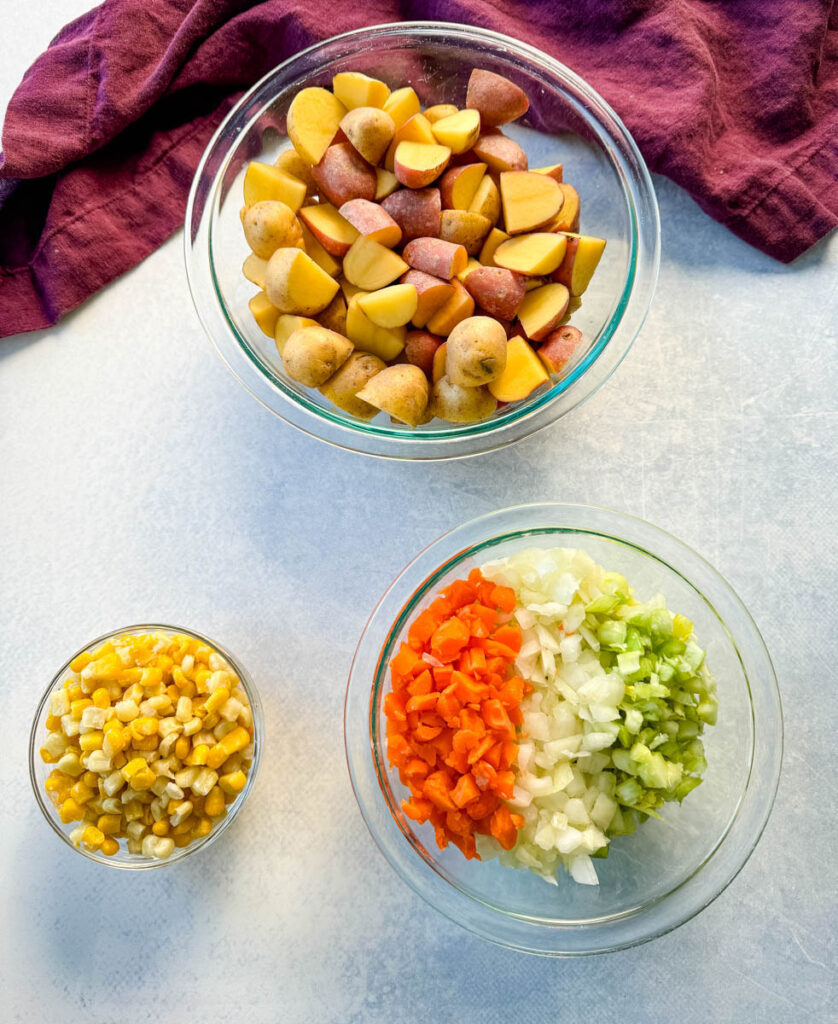
What Type of Salmon to Use
se is a matter of preference. You can even use store-bought smoked salmon if you wish. That way you don't have to cook anything and you can just toss it in.
The most common types of raw salmon include:
- Wild and/or Sockeye: Known for its deep red color and rich, oily flavor. It is considered one of the most flavorful types of salmon.
- Atlantic: It is farm-raised and has a milder flavor than wild-caught salmon.
- Pink: It is the smallest of the Pacific salmon and has a mild, delicate flavor.
Ultimately, the best type of fresh salmon to use will depend on your taste preferences.
Salmon that is sourced from the Atlantic is usually farmed. Farmed means antibiotics and food coloring (to give it a pink color) are used. This adds harmful chemical additives to the fish. So I usually try to look for wild-caught salmon.
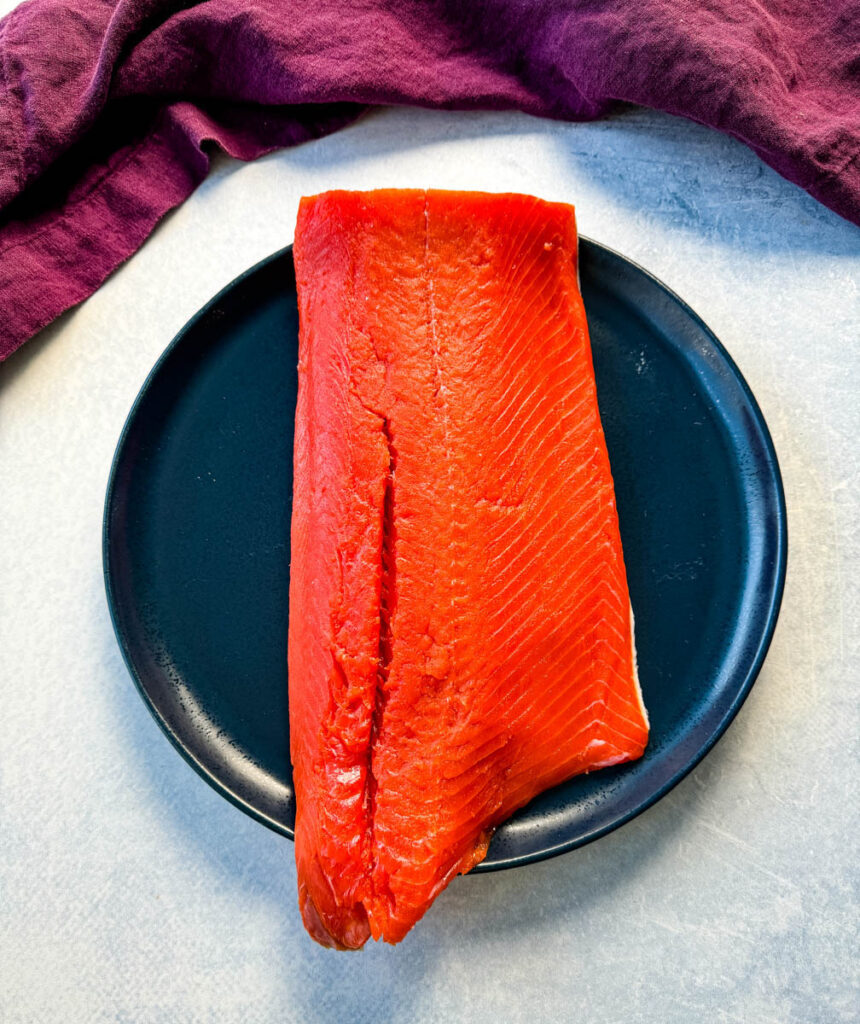
How to Cook the Salmon
How to Tell When Salmon is Perfectly Cooked
- Temperature: Use a meat thermometer and ensure the fish has reached an internal temperature of 145 degrees. Check the temperature in the thickest part of the fish.
- Appearance and Touch: Perfectly cooked salmon will have a light pink color and will be opaque throughout. The flesh will also start to flake when pressed with a fork.
- It’s important to note that salmon can be cooked to varying degrees of doneness, some people prefer it cooked through while others prefer it medium-rare at 135 degrees. Decide what works for you.
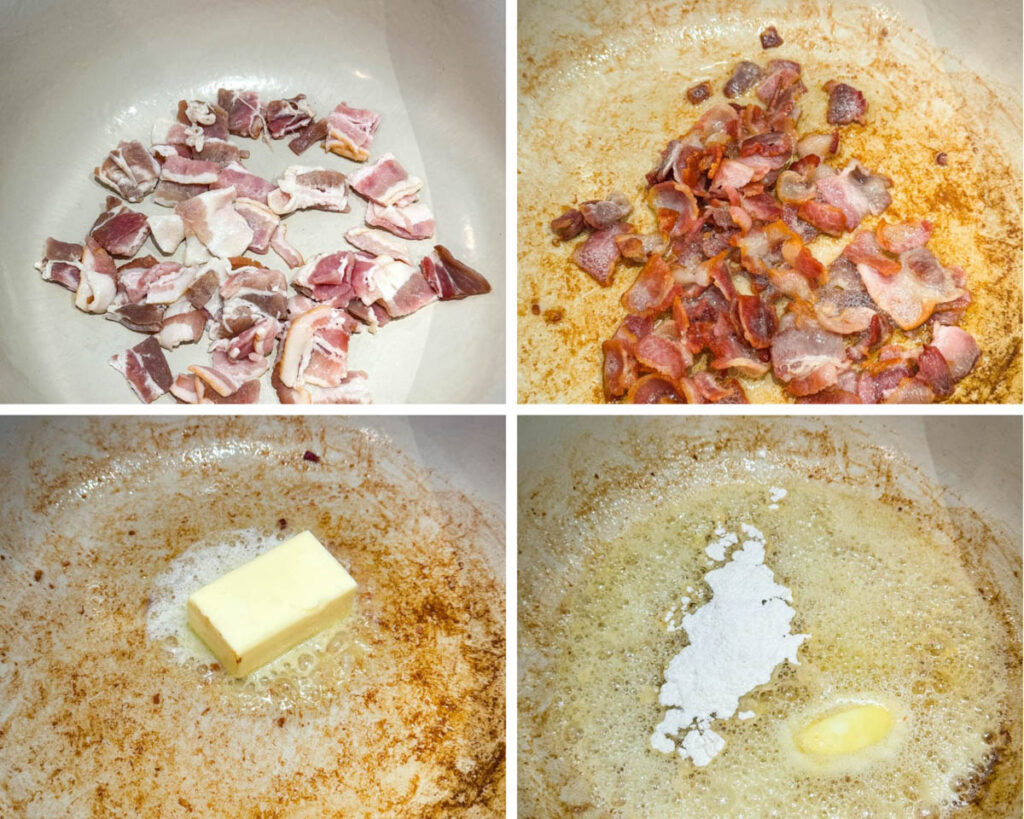
Fresh, Frozen, or Canned Corn
Any of these will work just fine in the recipe. If using frozen corn, thaw it first and squeeze out any excess moisture to avoid watery soup. I like to use frozen corn.
What Type of Potatoes to Use
When selecting potatoes, choose ones that are firm, smooth, and free from blemishes. The size and thickness of the potato chunks can be adjusted based on your preference. I love to use a combo of Yukon gold and red baby potatoes.
You can peel the potatoes or leave the skin on. I leave the skin on.
Here's a list of options:
- Yukon Gold: A popular choice due to their creamy texture and slightly sweet flavor. They hold their shape well and add a nice richness to the chowder.
- Red Potatoes: They have a smooth texture and hold their shape when cooked. They provide a slightly firmer bite compared to Yukon Gold potatoes.
- New Potatoes: New potatoes, which are young and small potatoes, work well. They have a thin skin and a firm, waxy texture.
- Russet Potatoes: While russet potatoes are commonly used for mashed potatoes or baking, they can also be used in chowders. However, they tend to break down more easily during cooking and may result in a softer texture. If using russet potatoes, you can cut them into larger chunks to help them maintain their shape.
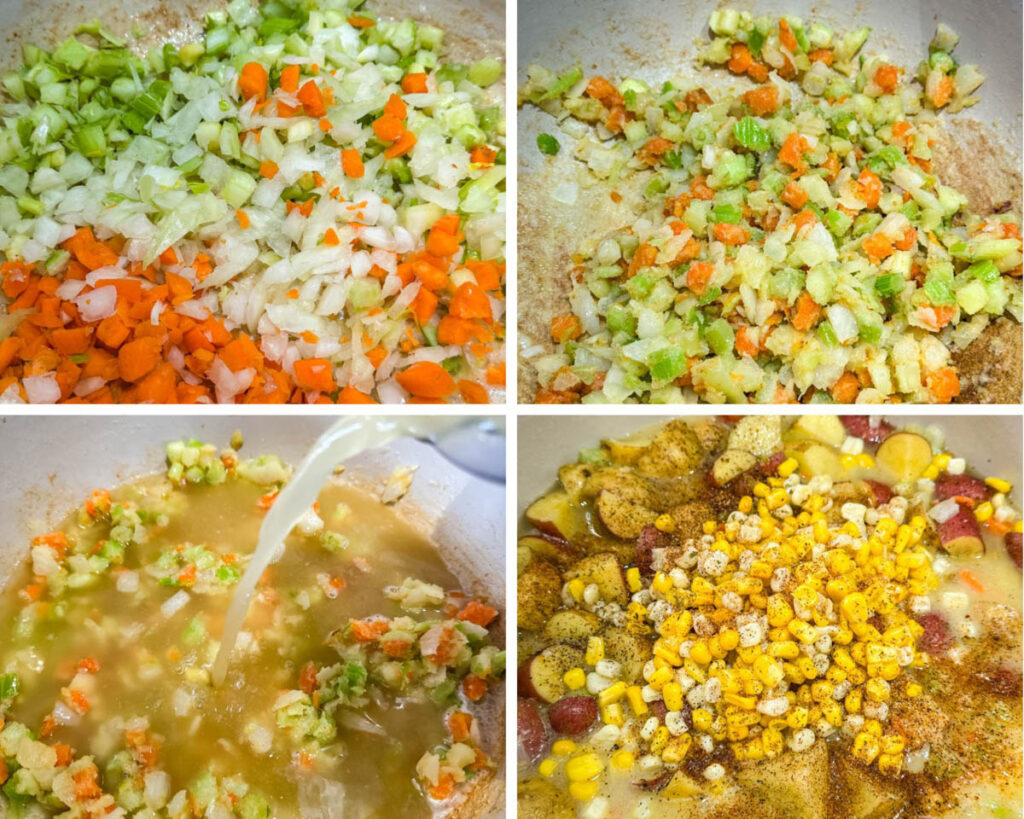
Spices
You can use a store-bought seafood or salmon rub or a blend of ½ teaspoon onion powder, ½ teaspoon garlic powder, and ½ teaspoon of smoked paprika.
Instead of a seafood seasoning, I like to use my Cajun Rub and Spice Blend.
You can use whatever you like to season the soup, just be sure to season it. The potatoes will be really bland without any addition of spices.
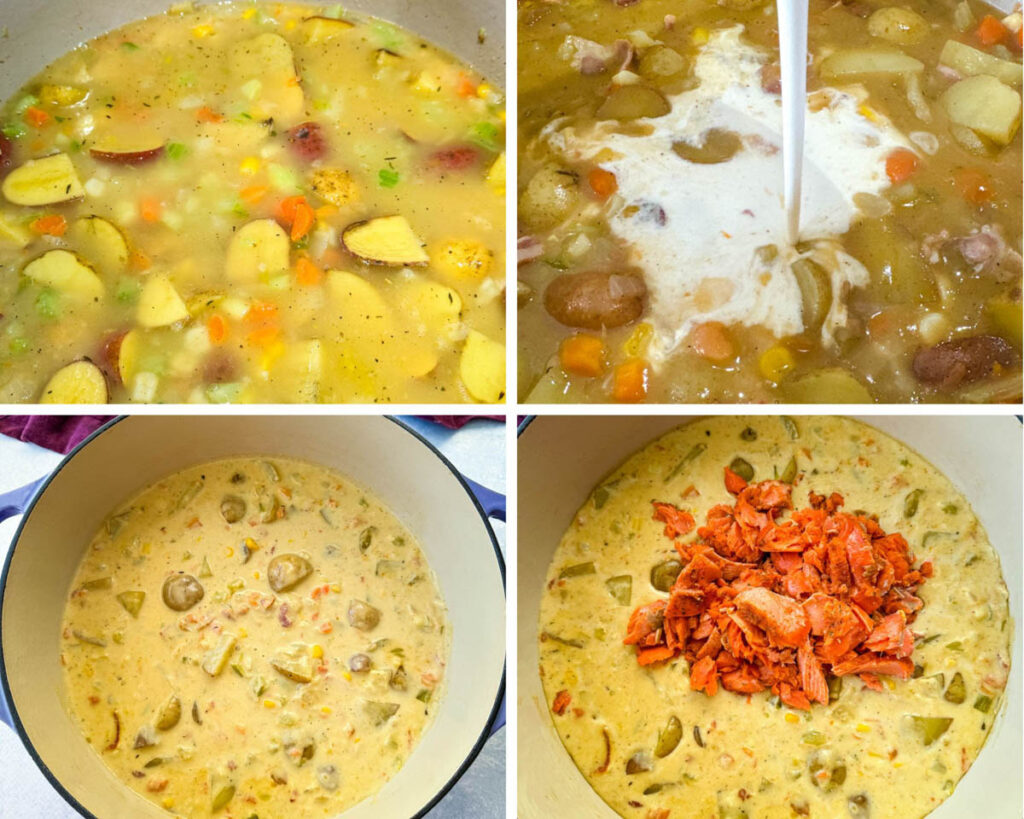
How to Make Creamy Salmon Chowder
Detailed measurements and full instructions can be found in the recipe card at the bottom of this post.
- Heat a Dutch oven or soup pot on medium heat and add chopped bacon. Cook until browned and crisp.
- Remove the bacon from the pot and set aside. Drain any excess bacon fat.
- Add butter to the pot on medium heat. When melted, add the flour in stages.
- Add celery, onions, and carrots to the roux and stir.
- Add garlic. Cook until the garlic is fragrant.
- Adjust the heat on the stove to medium-high. Add in broth/stock, potatoes, corn, cooked bacon, spices, and stir. Stir until the ingredients are well combined.
- Adjust to heat to low and place the lid on the pot. Simmer.
- Remove the lid and add in heavy cream.
- Add in the salmon and serve.
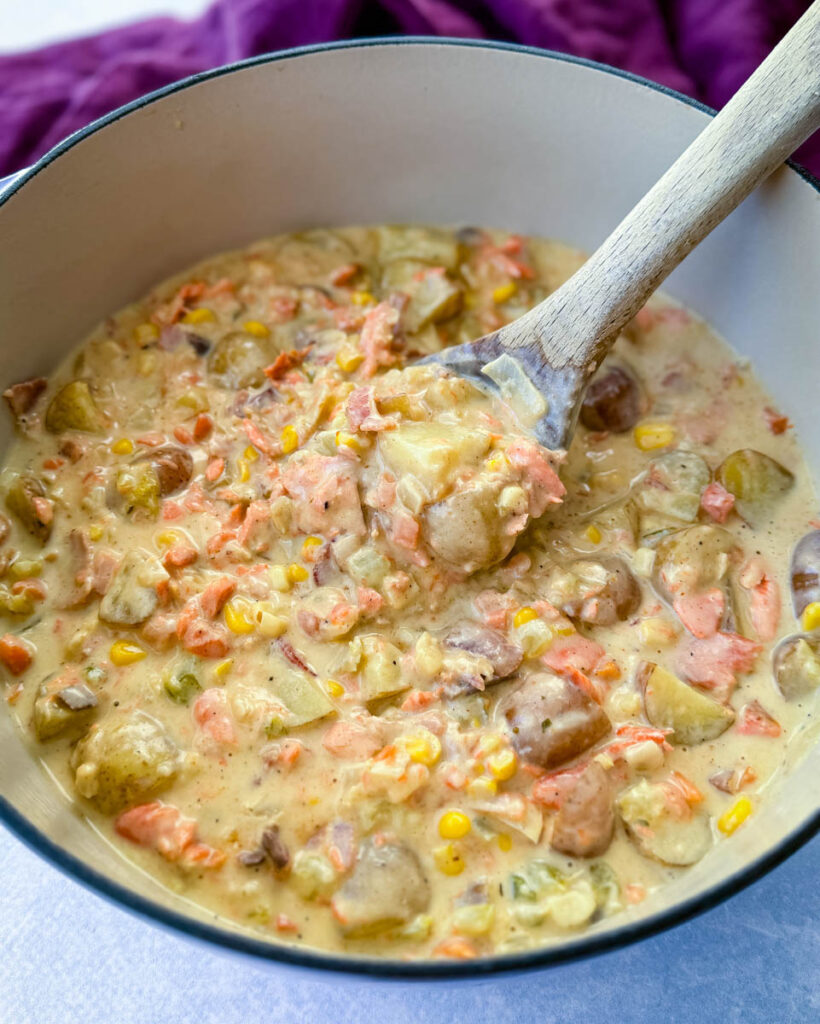
How to Get it Creamy
Heavy whipping cream will provide the perfect creamy texture. You can also substitute half and half or milk, but keep in mind these are thinner, so expect your texture to be thinner in comparison if you use it.
If you want to avoid dairy or a creamy soup, simply omit the heavy cream and milk. You can substitute additional broth or maybe even almond milk for the same serving amounts.
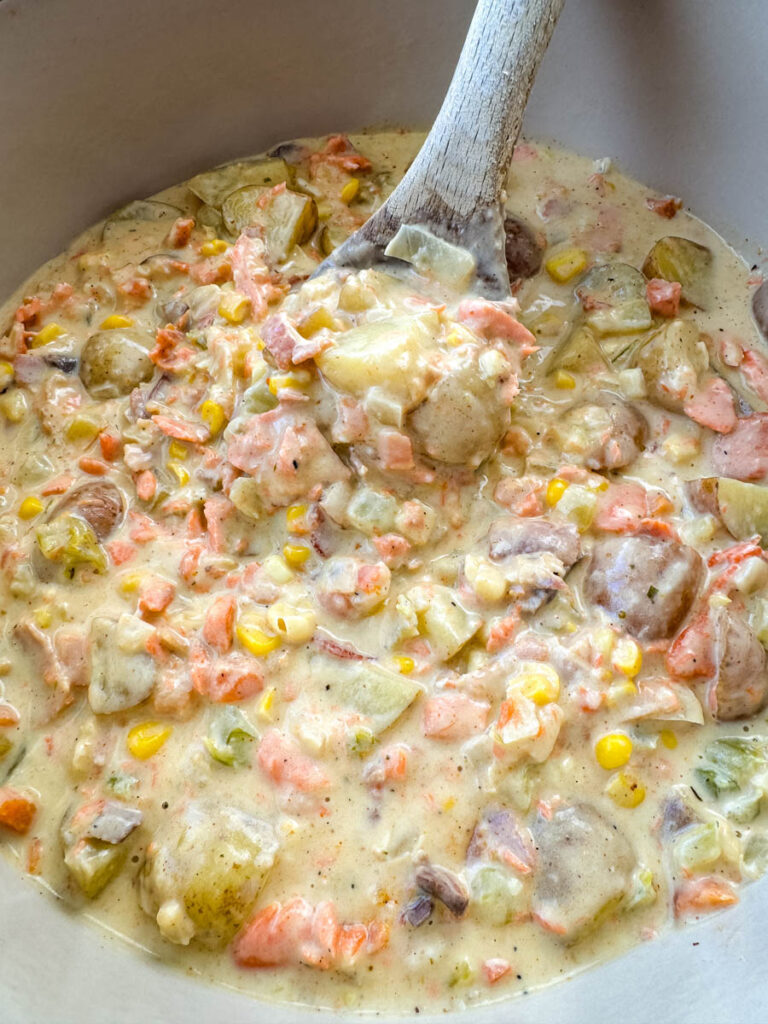
What Type of Pot to Use
The most suitable type is a heavy-bottomed soup pot or a Dutch oven. Choose a pot made of materials that conduct heat well, such as stainless steel, aluminum, or enameled cast iron.
Ensure the pot is large enough to hold all the ingredients comfortably. The chowder will include salmon, vegetables, broth, potatoes, and other ingredients, so having ample space is crucial.
A Dutch oven is an excellent option due to its thick, heavy bottom and even heat distribution. It's super useful here when sautéing vegetables, cooking the base, and simmering the chowder.
A standard soup pot with a capacity of at least 6 quarts is a versatile choice. It provides enough space to accommodate the ingredients for the chowder.
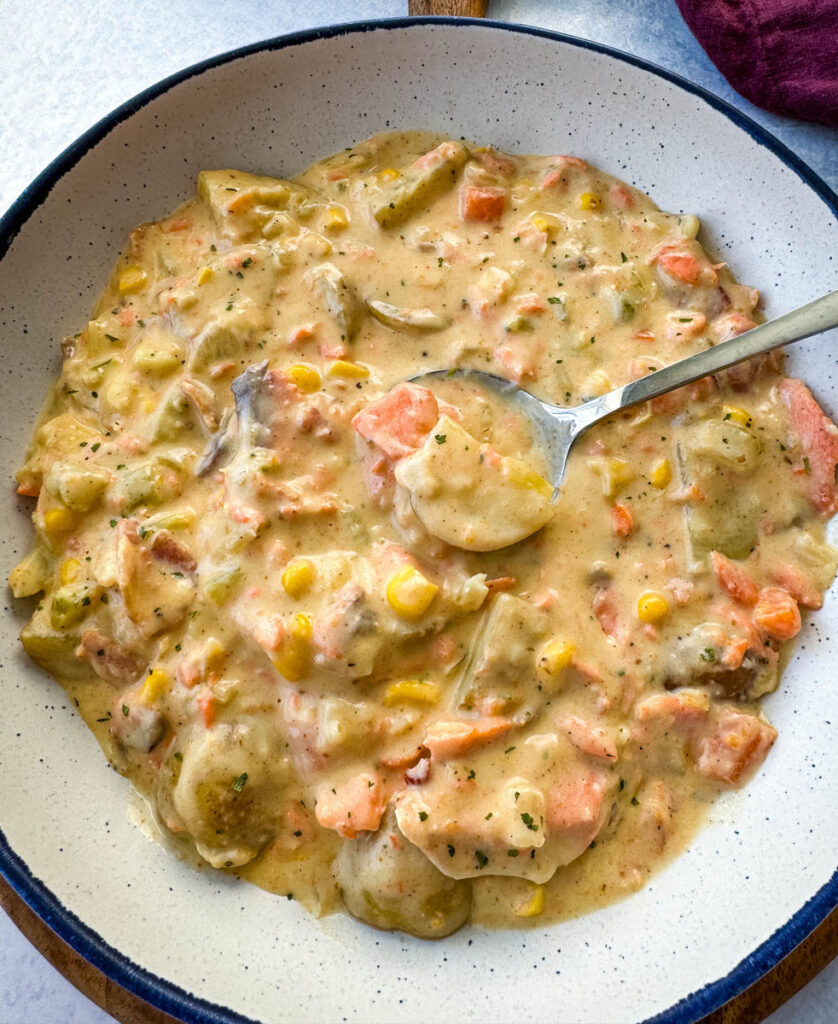
Substitution and Add-in Ideas
For soup with vegetables, my time-saving hack is to grab the Trader Joe's Mirepoix blend of diced carrots, celery, and onions. It saves so much time. Here are other things you can substitute:
- Crab
- Lobster
- Chicken
- Sausage
- Bell Peppers
- Green Beans
- Mushrooms
- Peas
- Grated Cheese
- Hot Sauce
- Sweet Potatoes
- Cauliflower
- Butternut Squash
How to Store Leftovers
Leftovers can be stored tightly covered and sealed for 3-4 days.
How to Reheat
Microwave the chowder in 1-minute intervals, stirring in between. This helps distribute the heat evenly.
You can also reheat it on the stove until warm.
If the chowder seems too thick after reheating, add a splash of broth, milk, or cream to achieve the desired consistency.
Freezer Tips
Freeze it tightly covered and sealed
This chowder is made with dairy. Dairy separates when thawed and reheated. This doesn't change the taste, but it will change the way the soup looks.
More Soup and Chowder Recipes
Roasted Creamy Poblano Soup
Homestyle Chicken Noodle Soup
Cajun Jambalaya Soup
Marry Me Chicken Soup
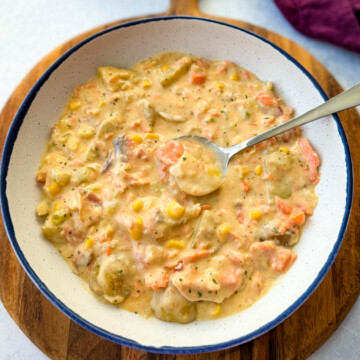
Creamy Salmon Corn Chowder
Want to save this recipe for later?
Equipment
Ingredients
- 3-4 slices bacon Optional; Chopped into 1 inch pieces.
- 4 tablespoons unsalted butter
- 4 tablespoons all-purpose flour
- ½ cup chopped carrots
- ½ cup chopped celery
- ½ cup chopped onions
- 3 garlic cloves Minced.
- 2 cups broth or stock Seafood, chicken, or vegetable stock.
- 1 pound potatoes I used red and Yukon; diced into 1-2 inch cubes.
- 10 oz corn Fresh frozen (thawed), or canned (drained)
- 1 teaspoon Seafood Seasoning See notes.
- salt and pepper to taste
- 1 cup heavy whipping cream
Salmon
- 1 teaspoon olive oil
- 1- 1 ½ pounds raw salmon
- ½ teaspoon smoked paprika Regular paprika is fine.
- ½ teaspoon onion powder
- ½ teaspoon garlic powder
- salt and pepper to taste
Instructions
Salmon
- Drizzle olive oil all over the salmon. Sprinkle the spices throughout and rub them into the salmon. Ensure the salmon is completely covered with spices and add additional if necessary.
Soup
- Heat a Dutch oven or soup pot on medium heat and add the chopped bacon. Cook until browned and crisp.
- Remove the bacon from the pot and set aside. Drain any excess bacon fat. I like to reserve about ½-1 inch of the fat in the pot for flavor.
- Add the butter to the pot on medium heat. When melted, add the flour in stages and stir. You add it in stages to avoid clumping. This will create a roux.
- Add the celery, onions, and carrots to the roux and stir. Cook for 3-4 minutes or until the vegetables are soft.
- Add the garlic. Cook until the garlic is fragrant.
- Adjust the heat on the stove to medium-high. Add in the broth/stock, potatoes, corn, cooked bacon, spices, salt, and pepper to taste and stir. Stir until the ingredients are well combined.
- Use enough broth to completely cover the potatoes. You can also use water if you are out of broth. The potatoes need to be covered in liquid in order to soften.
- Adjust to heat to low and place the lid on the pot. Simmer for 15-20 minutes or however long it takes for the potatoes to soften and become fork-tender.
- Cook the salmon while the soup simmers. See the steps below.
- Remove the lid and add in the heavy cream. Stir until creamy. Taste the chowder repeatedly and adjust the spices/salt/pepper as needed.
- Add in the cooked salmon and cook for 1-2 minutes and serve.
Air Fryer Salmon
- Spray the air fryer basket with cooking oil. Place the seasoned salmon in the air fryer basket.
- Air fry the salmon for 10-12 minutes at 370 degrees. Mine was ready right at 10 minutes. Use a meat thermometer and test that the inside of the salmon has reached 145 degrees.
Baked Salmon
- Preheat oven to 400 degrees.
- Add the seasoned salmon to a piece of foil large enough to hold the salmon and to wrap and cover it.
- Bake for 10 minutes.
- Unwrap the salmon so it is no longer fully covered. Bake for for another 2-5 minutes. Use a meat thermometer and ensure the fish has reached an internal temperature of 145 degrees. Check the temperature in the thickest part of the fish.
Pan Seared Salmon
- Place a skillet on medium-high heat with olive oil to coat and prevent sticking.
- When the pan is hot, add the seasoned salmon to the pan with the skin side up.
- Allow the salmon to cook for 4 minutes. Do not move the salmon after you have placed it in the skillet.
- Monitor the sides of the salmon to determine the perfect time to flip. When the color of the side of the salmon has lightened about ¾ths of the way up, it’s time to flip. This usually only takes 3-4 minutes.
- Flip the salmon. I find a silicone spatula works best.
- Cook skin side down for 4 minutes.
- Remove the salmon from the pan.
Notes
Nutrition
Nutrition Data
Macros are provided as a courtesy and should not be construed as a guarantee. This information is calculated using MyFitnessPal.com. To obtain the most accurate nutritional information in a given recipe, you should calculate the nutritional information with the actual ingredients used in your recipe, using your preferred nutrition calculator. You are solely responsible for ensuring that any nutritional information provided is accurate, complete, and useful.

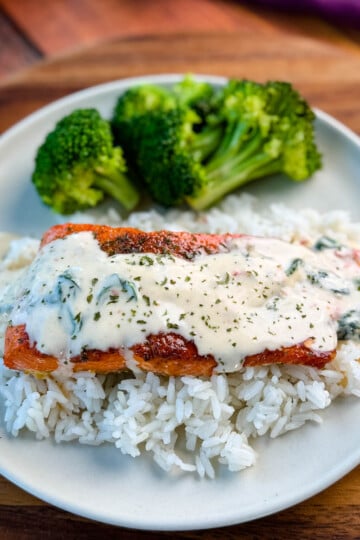
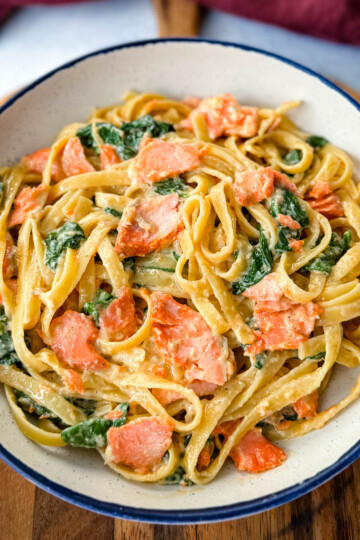
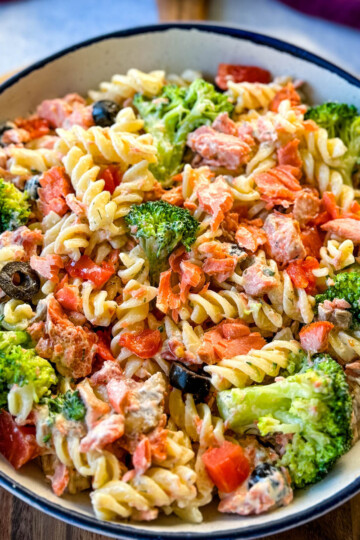
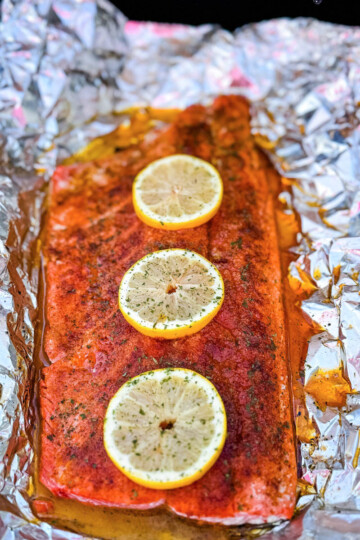
Leave a Reply